Golden Alexander
- September 25, 2023
- 0 comment
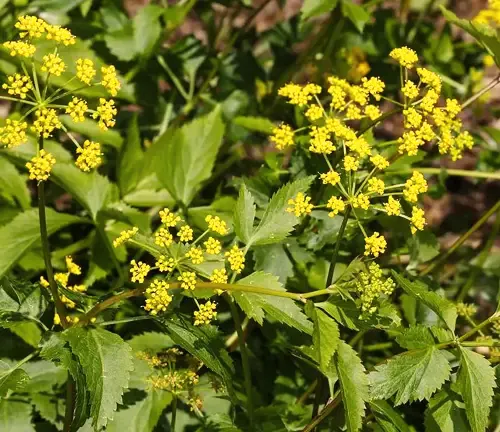
Golden Alexander, scientifically known as Zizia aurea, is a charming herbaceous plant native to North America. Belonging to the Apiaceae family, it’s characterized by its delicate, umbrella-like clusters of bright yellow flowers that bloom in late spring to early summer. The plant typically reaches a height of one to two feet and features pinnately compound leaves with toothed leaflets. Golden Alexander is commonly found in moist meadows, prairies, and along stream banks, adding a burst of color and attracting pollinators like bees and butterflies with its nectar-rich blooms.
The blossoms of Golden Alexander are borne in umbrella-like clusters called umbels. These clusters can vary in size, but they typically consist of dozens of small, five-petaled flowers. Each individual flower is a rich shade of yellow, and when the whole plant is in full bloom, it creates a striking visual display. Golden Alexander usually flowers in late spring to early summer, and its blooms persist for several weeks, providing a valuable source of nectar for pollinators during this time.
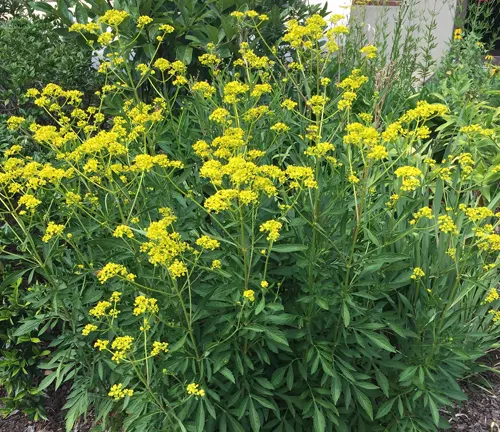
This wildflower is highly adaptable and can be found in a range of natural habitats, including meadows, prairies, savannas, and the edges of deciduous woodlands. Its adaptability extends to soil types as well, as it can thrive in both moist and well-drained soils. This versatility makes it a favorite among gardeners and conservationists who are keen on creating wildlife-friendly landscapes.
| Characteristic | Description |
| Scientific Name | Zizia aurea |
| Common Names | Golden Alexander, Golden Zizia |
| Plant Type | Herbaceous Perennial |
| Height | 1 to 2 feet (30 to 60 centimeters) |
| Foliage | Compound leaves with finely divided leaflets |
| Flower Color | Golden-yellow |
| Flowering Season | Late spring to early summer |
| Flower Arrangement | Umbels (clusters) |
| Habitat | Meadows, prairies, savannas, woodland edges |
| Soil Type | Adaptable, thrives in both moist and well-drained soils |
| Adaptability | Tolerant of a variety of soil and habitat conditions |
| Conservation Use | Often used in ecological restoration projects |
| Garden Use | Suitable for pollinator gardens and naturalistic landscapes |
| Maintenance | Low maintenance, easy to grow |
Getting to Know Golden Alexander
Nestled among the natural wonders of North America, Golden Alexander (Zizia aurea) stands out as a botanical beauty worth knowing. With its striking golden-yellow blooms and graceful foliage, this perennial wildflower has captivated the hearts of both nature enthusiasts and conservationists. In this article, we’ll take a closer look at this woodland elegance and explore its ecological importance, cultivation, and the benefits it brings to both landscapes and wildlife.
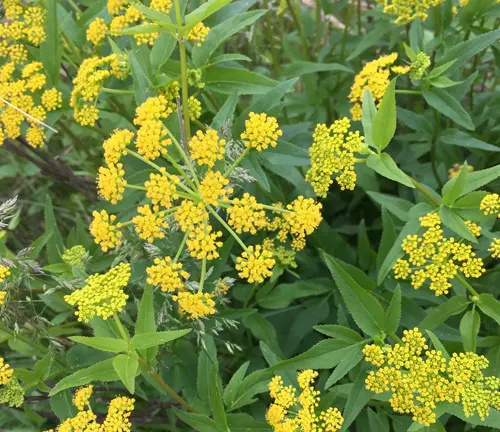
Woodland Elegance
Golden Alexander is a true gem of North American flora. Its botanical elegance lies in its compound leaves, which are finely divided into numerous leaflets, resembling delicate fern fronds. These lush, green leaves provide the perfect backdrop for the main attraction – the golden-yellow flower clusters. Blooming in late spring to early summer, these vibrant umbels create a breathtaking display in natural landscapes. The combination of finely textured leaves and golden blossoms makes Golden Alexander a sought-after addition to gardens seeking to evoke the charm of the wild.
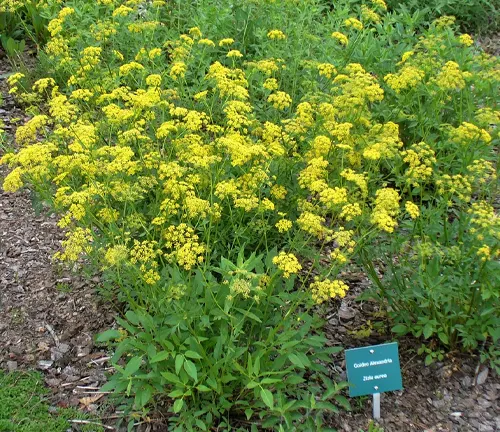
Ecological Importance
Nature’s intricate web relies on pollinators, and Golden Alexander plays a vital role in supporting these essential creatures. Its nectar-rich flowers are a magnet for bees and butterflies, providing them with sustenance and promoting pollination. By cultivating Golden Alexander, gardeners can contribute to the conservation of these important pollinators, helping to ensure the health of local ecosystems.


Cultivation and Conservation
One of the remarkable attributes of Golden Alexander is its adaptability. It thrives in a variety of habitats, from moist meadows to the edges of woodlands. Gardeners find it easy to grow, making it an ideal choice for naturalistic landscapes and pollinator gardens. Moreover, conservationists frequently employ Golden Alexander in habitat restoration projects to reintroduce native plant species and stabilize disturbed areas, demonstrating its value beyond its aesthetic appeal.
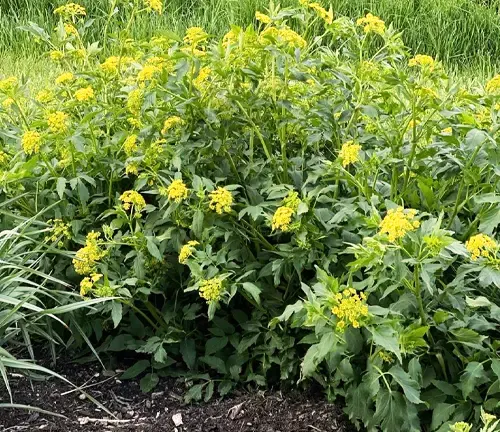
Fragrance
Golden Alexander offers more than just visual delight. If you take a moment to smell its flowers, you’ll be pleasantly surprised. While not intensely fragrant, their subtle, sweet scent adds an extra layer of sensory pleasure to any garden or natural setting.
Soil Stabilization
The dense root system of Golden Alexander plays a crucial role in soil stabilization. Its extensive, fibrous roots help prevent erosion by holding the soil in place. This makes it an excellent choice for gardens or landscapes in need of erosion control, especially on slopes or in areas with loose soil.
Benefits Beyond Beauty
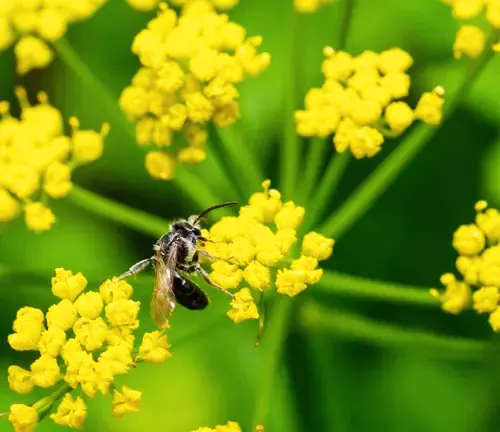
Beyond its stunning appearance and ecological contributions, Golden Alexander offers numerous benefits. Its low maintenance requirements make it a practical choice for gardeners looking to enhance their landscapes while conserving water and resources. Additionally, its role in supporting local biodiversity contributes to the overall health and resilience of natural ecosystems.
Different Species of Zizia Genus
Zizia aptera
Also known as Meadow Alexander, Zizia aptera is another North American native species. It typically has white or greenish flowers and is found in moist meadows and wetlands. Its leaves are less finely divided compared to Zizia aurea.
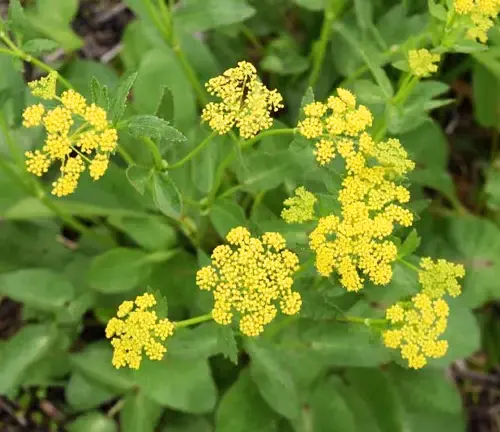
Zizia trifoliata
This species is commonly called Three-leaf Golden Alexander. It is native to the eastern United States and is named for its distinctive three-part leaves. The flowers are typically yellow and arranged in umbels. Zizia trifoliata prefers woodland settings and can be found in rich, moist soils.
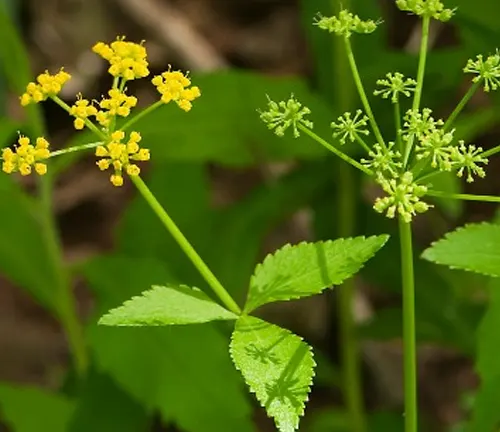
Zizia integerrima
Native to the southeastern United States, Zizia integerrima is known as Heart-leaved Golden Alexander due to the shape of its leaves. It produces clusters of yellow flowers and thrives in a variety of habitats, including meadows and woodlands.
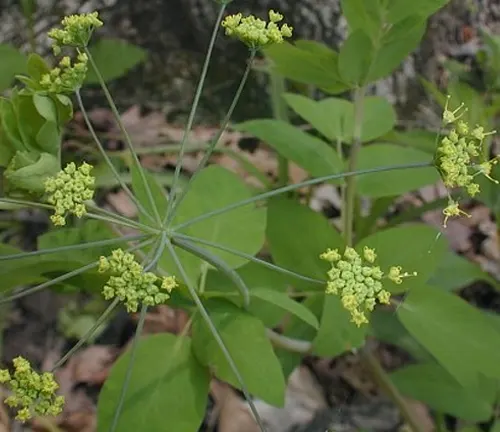
Conclusion
Golden Alexander is more than just a pretty face in the world of wildflowers. Its graceful appearance, ecological importance, adaptability, and practical benefits make it a versatile and valuable addition to gardens and conservation efforts alike. Whether you’re drawn to its woodland elegance or its role in supporting pollinators and stabilizing soil, Golden Alexander proves that beauty in nature often goes hand in hand with functionality and ecological significance.
Frequently Asked Questions (FAQs)
- Is Golden Alexander related to the famous conqueror Alexander the Great?
No, Golden Alexander is not related to the historical figure Alexander the Great. Its name is derived from its golden-yellow flowers and elegant appearance in the wild, rather than any historical connection. - Can I use Golden Alexander in culinary recipes like other plants in the carrot family?
While some plants in the carrot family are used in culinary recipes, Golden Alexander is not typically consumed by humans. It lacks the enlarged, fleshy roots characteristic of edible plants like carrots and parsnips. Instead, it is primarily valued for its ornamental and ecological qualities. - Is Golden Alexander toxic to pets or wildlife?
Golden Alexander is not known to be toxic to pets or wildlife. In fact, it plays a valuable role in supporting pollinators like bees and butterflies by providing nectar. However, it’s always a good practice to ensure that any plant or flower you introduce to your garden is safe for the specific wildlife in your area. - Can I grow Golden Alexander in containers or pots?
While Golden Alexander is typically grown in garden beds or naturalistic landscapes, it can also be cultivated in containers or pots. Just make sure the container provides enough space for its root system, and ensure that it receives adequate sunlight and moisture. - Does Golden Alexander have any traditional medicinal uses?
Golden Alexander is not widely recognized for traditional medicinal uses. Unlike some other members of the carrot family, it is not known for its culinary or medicinal properties. However, its ecological importance in supporting pollinators and its role in habitat restoration make it a valuable plant in conservation efforts.


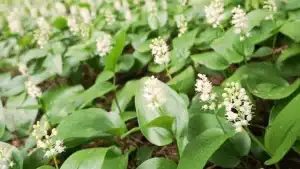
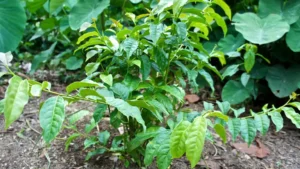
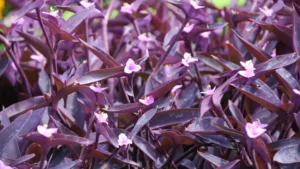

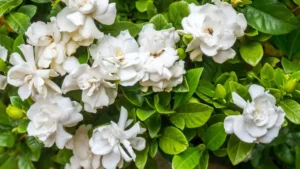
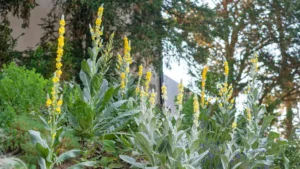
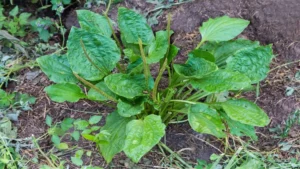

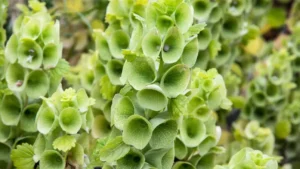
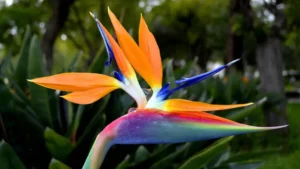


Leave your comment